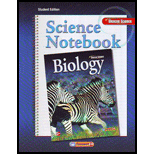
Concept explainers
To complete:
The given table to compare the composition and functions of the four major groups of biological macromolecules.
Introduction:
Macromolecules such as proteins, lipids,
Answer to Problem 6MI
Composition and functions of the four major groups of biological macromolecules are given in the table
| Group | Composition | Functions |
| Proteins | Amino acids made of carbon, hydrogen, oxygen, nitrogen and sometimes sulfur | Transport of substances, |
| Nucleic acids | The polymer of nucleotides, each | Store and communicate genetic information |
| Carbohydrates | Carbon, hydrogen, and oxygen in the ratio of one oxygen and two hydrogen for each carbon | Store energy; provide structural support |
| Lipids | Lipids are made of hydrocarbons | Store energy; provide steroids; waterproof coatings |
Explanation of Solution
Organisms are made up of carbon-based molecules. Carbon compounds are the basic building blocks of living organisms. Biological macromolecules are formed by joining small carbon compounds into polymers. Proteins, carbohydrates, lipids and nucleic acids are four types of biological macromolecules. Carbohydrate such as cellulose and starch are macromolecules made of monomers. Proteins are polypeptides. Peptide bonds join amino acids in proteins. The nucleic acid is polynucleotides. Chains of nucleotides form nucleic acids. Lipids are made of fatty acids, glycerol and other components.
Chapter 6 Solutions
Biology Science Notebook
Additional Science Textbook Solutions
Human Biology: Concepts and Current Issues
Study Guide for Campbell Biology
Essentials of Genetics (9th Edition) - Standalone book
Campbell Biology (11th Edition)
Microbiology with Diseases by Body System (5th Edition)
Fundamentals of Anatomy & Physiology Plus Mastering A&P with eText - Access Card Package (10th Edition) (New A&P Titles by Ric Martini and Judi Nath)
 Human Anatomy & Physiology (11th Edition)BiologyISBN:9780134580999Author:Elaine N. Marieb, Katja N. HoehnPublisher:PEARSON
Human Anatomy & Physiology (11th Edition)BiologyISBN:9780134580999Author:Elaine N. Marieb, Katja N. HoehnPublisher:PEARSON Biology 2eBiologyISBN:9781947172517Author:Matthew Douglas, Jung Choi, Mary Ann ClarkPublisher:OpenStax
Biology 2eBiologyISBN:9781947172517Author:Matthew Douglas, Jung Choi, Mary Ann ClarkPublisher:OpenStax Anatomy & PhysiologyBiologyISBN:9781259398629Author:McKinley, Michael P., O'loughlin, Valerie Dean, Bidle, Theresa StouterPublisher:Mcgraw Hill Education,
Anatomy & PhysiologyBiologyISBN:9781259398629Author:McKinley, Michael P., O'loughlin, Valerie Dean, Bidle, Theresa StouterPublisher:Mcgraw Hill Education, Molecular Biology of the Cell (Sixth Edition)BiologyISBN:9780815344322Author:Bruce Alberts, Alexander D. Johnson, Julian Lewis, David Morgan, Martin Raff, Keith Roberts, Peter WalterPublisher:W. W. Norton & Company
Molecular Biology of the Cell (Sixth Edition)BiologyISBN:9780815344322Author:Bruce Alberts, Alexander D. Johnson, Julian Lewis, David Morgan, Martin Raff, Keith Roberts, Peter WalterPublisher:W. W. Norton & Company Laboratory Manual For Human Anatomy & PhysiologyBiologyISBN:9781260159363Author:Martin, Terry R., Prentice-craver, CynthiaPublisher:McGraw-Hill Publishing Co.
Laboratory Manual For Human Anatomy & PhysiologyBiologyISBN:9781260159363Author:Martin, Terry R., Prentice-craver, CynthiaPublisher:McGraw-Hill Publishing Co. Inquiry Into Life (16th Edition)BiologyISBN:9781260231700Author:Sylvia S. Mader, Michael WindelspechtPublisher:McGraw Hill Education
Inquiry Into Life (16th Edition)BiologyISBN:9781260231700Author:Sylvia S. Mader, Michael WindelspechtPublisher:McGraw Hill Education





